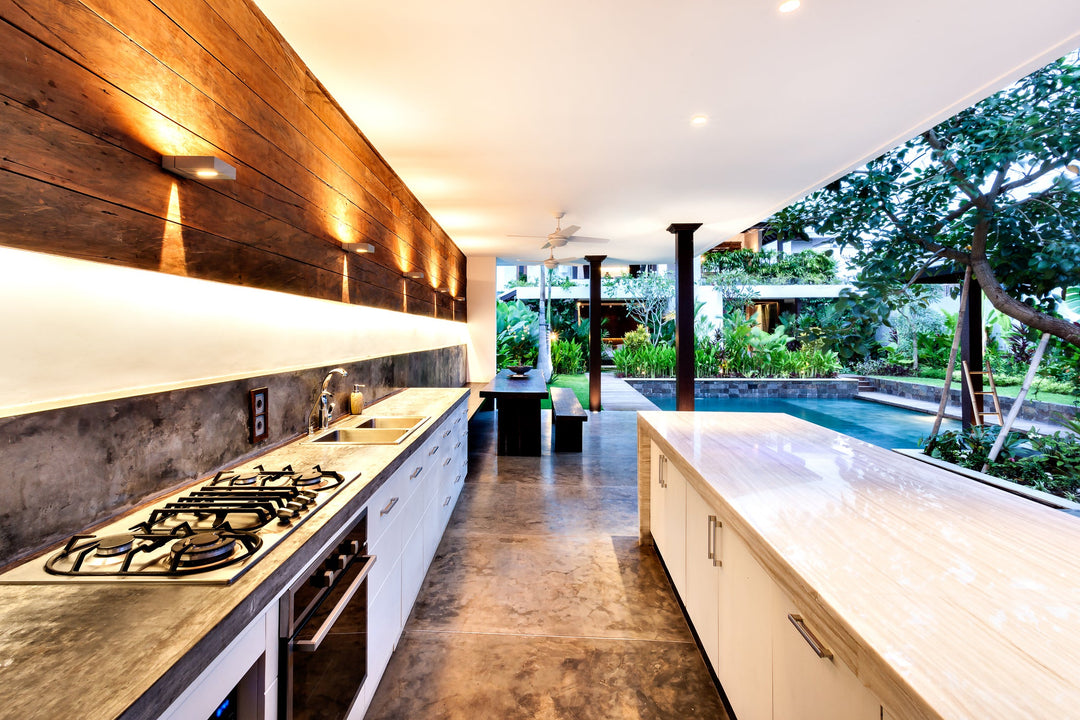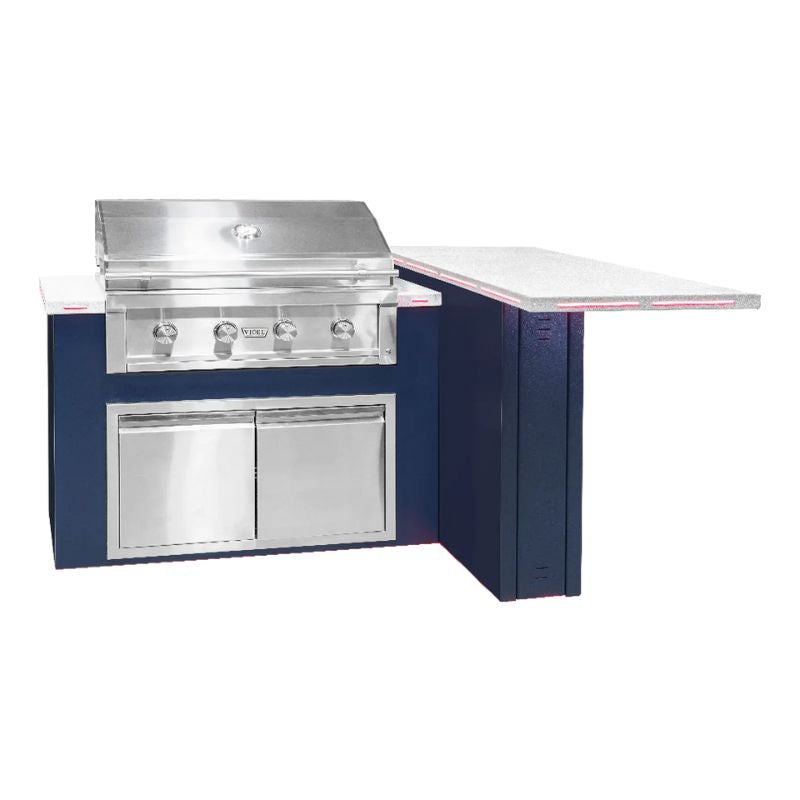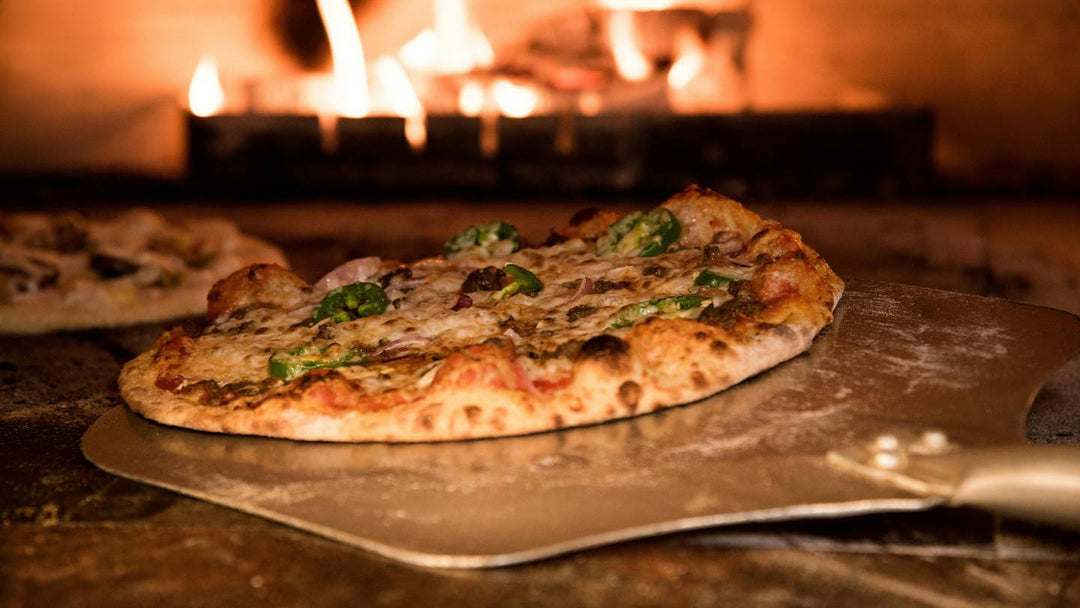The Comprehensive Outdoor Kitchen Buying Guide For 2025
Buyer's Guide for Outdoor Kitchens in 2025
Upgrading your backyard with a luxury outdoor kitchen is a great way to enhance the value and enjoyment of your life. A well-designed outdoor kitchen extends your living space, offering a comfortable spot to cook, dine, and unwind outdoors. Modern outdoor kitchens combine high-quality performance with stylish design, durable materials, and flexible layouts, allowing you to showcase your personal taste. Whether you want a small island or a full outdoor cooking area, it’s essential to understand the key components, materials, design choices, and installation steps that make your kitchen both durable and practical.
Understanding the Role of the Outdoor Kitchen
An outdoor kitchen not only improves your lifestyle but can also raise your home’s value. Many people add outdoor kitchens to make better use of their space, letting them cook, eat, and entertain outside when the weather is nice. It’s also easier to spend time with guests while cooking, instead of being stuck inside. For those who love to host, an outdoor kitchen becomes a central spot for grilling, prepping, serving, and relaxing. As more homeowners focus on outdoor living, a well-designed kitchen can make your property more attractive, especially in areas where outdoor spaces are in demand.
Prefab Islands vs. Custom Outdoor Kitchens
One of the first decisions you’ll face is whether to purchase a prefabricated outdoor kitchen island or opt for a custom design. Prefab or ready-to-assemble islands are great if you want a quick and easy way to set up a complete grilling and prep area. These islands come with all the main components included, such as the grill, cabinets, countertops, and finished exterior, so you don’t have to spend on each piece separately. They’re much easier to put together than building from scratch and can save you time and money. Prefab kitchens are a good option if you want a stylish, complete setup without having to handle every detail yourself.
Custom outdoor kitchens are best for those who want complete control over the design and build. With a custom setup, you can choose every detail, from materials and appliances to finishes, counter sizes, and even the shape of the kitchen. While this option typically costs more and takes longer to build, it allows you to create a kitchen that perfectly matches your exact needs and style. Custom kitchens are particularly well-suited for high-end projects or spaces with unique requirements, offering flexibility that prefab options can’t provide.
Planning the Layout
A great outdoor kitchen begins with thoughtful planning. The layout should facilitate easy preparation, cooking, serving, and spending time with others. Start by thinking about how you’ll use the space—just for grilling and simple meals, or as a full entertaining area with prep space, a fridge, seating, and work areas. The classic work triangle from indoor kitchens also works outside: arrange the grill, sink, and fridge so you can move easily between them. Keep cooking areas away from seating areas to ensure everyone's comfort and safety. Also, ensure there’s enough counter space near the grill for prepping and serving food.
It’s also important to separate the cooking area from the beverage and serving zones. This helps avoid crowding around the grill and keeps things safer. Ensure there’s sufficient space for people to move around easily, with wide, clear paths and ample room for appliances to open fully. A well-designed layout should not only look great but also function well, resulting in a kitchen that’s both attractive and practical.
Choosing the Core Components
The grill is the centerpiece of nearly every outdoor kitchen and often dictates the rest of the layout. Buyers must first choose between fuel types—gas, propane, charcoal, or pellet—based on cooking preferences and available utilities. Gas and propane grills provide precise temperature control and convenience, while charcoal and pellet grills appeal to those who prioritize flavor and smoking capabilities. Many homeowners incorporate multiple cooking methods, adding side burners, smokers, pizza ovens, or infrared sear stations to expand their culinary possibilities.
Countertops are an equally essential component, serving as work surfaces for prep, dining, or beverage service. Materials such as granite, concrete, porcelain, and stainless steel are among the most durable choices, each offering its own aesthetic and performance benefits. Granite provides timeless beauty and heat resistance; stainless steel introduces a modern, professional look; porcelain combines elegant style with exceptional weather resistance; and concrete offers nearly endless customization options. The right countertop choice strikes a balance between durability and design cohesion.
Storage is also important. Cabinets and drawers that can handle the weather keep your tools, cookware, spices, and utensils nearby, so you don’t have to keep going inside. Stainless steel is a top choice for storage because it lasts a long time and withstands moisture and heat.
Additional components such as sinks, refrigerators, beverage centers, kegerators, ice makers, and warming drawers further elevate the functionality of an outdoor kitchen. While a sink dramatically improves prep and cleanup, refrigeration ensures ingredients and drinks stay cold without requiring trips indoors. For many homeowners, these conveniences transform their outdoor space into a true second kitchen.
Selecting Materials That Endure the Outdoors
Outdoor kitchens must withstand far more stress than their indoor counterparts. Temperature extremes, moisture, UV exposure, and seasonal wear all influence the lifespan of materials. Durable metals such as 304 stainless steel are the gold standard for appliances and cabinetry, offering corrosion resistance and structural integrity. For the exterior finish of a kitchen island, materials like stucco, stone, brick, powder-coated steel, and GFRC concrete are common choices. Each brings its own style: stucco delivers a clean, textured appearance; brick provides a classic, timeless look; GFRC concrete offers sculptural and modern appeal; and powder-coated finishes introduce a sleek contemporary feel with broad color options.
Countertop material selection is equally crucial. Granite is highly resistant to heat and scratches; concrete can be customized in shape, thickness, and color; porcelain offers exceptional UV resistance and low maintenance; stainless steel delivers industrial strength; and natural stone adds organic beauty. The ideal material must strike a balance between durability, aesthetic preference, and maintenance requirements.
Ventilation, Safety, and Utility Planning
Safety and proper setup are essential for outdoor kitchens. Built-in gas grills require good ventilation to prevent gas from accumulating inside the island. Propane requires vents to be placed low, as it’s heavier than air, while natural gas needs vents higher up because it rises. Ensure there’s sufficient space between the kitchen and other structures, and consider installing a vent hood if you plan to cook under a cover or in a partially enclosed area.
Planning for utilities is just as important. Gas lines, electrical wiring, and water hookups must comply with local building codes. In many cases, you’ll need a professional to install things like natural gas lines, electrical outlets, or plumbing for sinks and appliances. Even if you’re handy, it’s best to hire licensed pros when building code regulations are involved.
Installation Considerations
The installation requirements of an outdoor kitchen vary significantly depending on whether the setup is prefabricated or custom-built. Prefab islands typically arrive flat-packed and require assembly of panels, appliances, and countertops. While the assembly is straightforward, these units are heavy, and homeowners should plan for sufficient help when moving boxes or positioning the island. Countertops and appliances must be carefully installed, and final appliance hookups, particularly those involving gas, should be completed by licensed technicians for safety and to preserve warranties.
Custom kitchens involve more extensive installation processes, including construction of the island foundation, framing, finish application, countertop fabrication, and utility connections. Although more complex, a custom installation allows the kitchen to feel architecturally integrated with the home and surrounding landscape.
Maintenance and Longevity
Proper maintenance ensures your outdoor kitchen remains beautiful and functional for years to come. Stainless steel appliances should be cleaned with appropriate cleaners to prevent corrosion, while powder-coated surfaces should be wiped with gentle, non-abrasive cloths. Granite and stone countertops may require periodic sealing depending on the material. Grills benefit from regular deep cleaning to remove grease buildup, while refrigerators and sinks need routine sanitation. Protective covers are highly recommended, especially in regions with harsh winters or frequent rain, as they prevent moisture damage and reduce wear across appliances and cabinetry. Winterizing is essential in colder climates—draining water lines, disconnecting hoses, and storing removable components helps prevent freeze damage.
Budget Expectations
The cost of an outdoor kitchen can vary significantly based on the materials, appliances, size, and level of customization you desire. A simple island with a grill and some storage is more affordable. At the same time, a custom kitchen with top-of-the-line appliances, fancy countertops, pizza ovens, refrigerators, and bar seating can be a significant investment. Don’t forget to budget for items such as utility hookups, landscaping, vent hoods, and regular maintenance. Many people see this as both a way to enjoy life more and to add value to their home.
Elevating the Experience with Design and Style
Today’s outdoor kitchens focus on both looks and function. Modern designs feature clean lines, stainless steel, and neutral tones, while rustic kitchens utilize natural materials and warm colors. Mediterranean styles often feature stucco, clay tiles, wrought iron, and abundant plants, while tropical kitchens incorporate teak, bamboo, and lush greenery to evoke a resort feel. No matter your style, try to match your kitchen to your home and yard for a welcoming outdoor space.
Final Thoughts
A luxury outdoor kitchen is far more than a place to grill—it becomes the anchor of your outdoor living space, enabling an exceptional cooking experience. It becomes the heart of your outdoor space, making cooking and gatherings special. Whether you choose a ready-to-assemble island or a custom-built kitchen, the best results come from using strong materials, smart layouts, quality appliances, and good planning. With these features in place, your outdoor kitchen will be a lasting, beautiful addition to your home, enhancing your lifestyle and property value for years to come.
Check out Fire Goddess' large selection of outdoor kitchens and barbecue islands

















Leave a comment